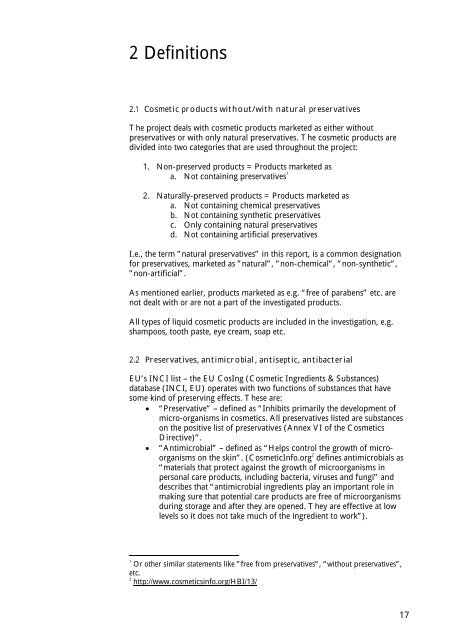Survey and health assessment of cosmetic products ... - Miljøstyrelsen
Survey and health assessment of cosmetic products ... - Miljøstyrelsen
Survey and health assessment of cosmetic products ... - Miljøstyrelsen
Create successful ePaper yourself
Turn your PDF publications into a flip-book with our unique Google optimized e-Paper software.
2 Definitions<br />
2.1 Cosmetic <strong>products</strong> without/with natural preservatives<br />
The project deals with <strong>cosmetic</strong> <strong>products</strong> marketed as either without<br />
preservatives or with only natural preservatives. The <strong>cosmetic</strong> <strong>products</strong> are<br />
divided into two categories that are used throughout the project:<br />
1. Non-preserved <strong>products</strong> = Products marketed as<br />
a. Not containing preservatives 1<br />
2. Naturally-preserved <strong>products</strong> = Products marketed as<br />
a. Not containing chemical preservatives<br />
b. Not containing synthetic preservatives<br />
c. Only containing natural preservatives<br />
d. Not containing artificial preservatives<br />
I.e., the term ”natural preservatives” in this report, is a common designation<br />
for preservatives, marketed as ”natural”, ”non-chemical”, ”non-synthetic”,<br />
”non-artificial”.<br />
As mentioned earlier, <strong>products</strong> marketed as e.g. “free <strong>of</strong> parabens” etc. are<br />
not dealt with or are not a part <strong>of</strong> the investigated <strong>products</strong>.<br />
All types <strong>of</strong> liquid <strong>cosmetic</strong> <strong>products</strong> are included in the investigation, e.g.<br />
shampoos, tooth paste, eye cream, soap etc.<br />
2.2 Preservatives, antimicrobial, antiseptic, antibacterial<br />
EU’s INCI list – the EU CosIng (Cosmetic Ingredients & Substances)<br />
database (INCI, EU) operates with two functions <strong>of</strong> substances that have<br />
some kind <strong>of</strong> preserving effects. These are:<br />
� “Preservative” – defined as “Inhibits primarily the development <strong>of</strong><br />
micro-organisms in <strong>cosmetic</strong>s. All preservatives listed are substances<br />
on the positive list <strong>of</strong> preservatives (Annex VI <strong>of</strong> the Cosmetics<br />
Directive)”.<br />
� “Antimicrobial” – defined as “Helps control the growth <strong>of</strong> microorganisms<br />
on the skin”. (CosmeticInfo.org 2<br />
defines antimicrobials as<br />
“materials that protect against the growth <strong>of</strong> microorganisms in<br />
personal care <strong>products</strong>, including bacteria, viruses <strong>and</strong> fungi” <strong>and</strong><br />
describes that “antimicrobial ingredients play an important role in<br />
making sure that potential care <strong>products</strong> are free <strong>of</strong> microorganisms<br />
during storage <strong>and</strong> after they are opened. They are effective at low<br />
levels so it does not take much <strong>of</strong> the ingredient to work”).<br />
1<br />
Or other similar statements like ”free from preservatives”, “without preservatives”,<br />
etc.<br />
2<br />
http://www.<strong>cosmetic</strong>sinfo.org/HBI/13/<br />
17

















